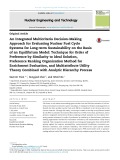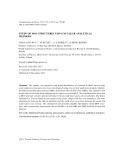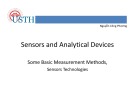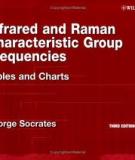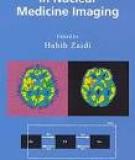
Nuclear analytical methods
-
: In this study, quantative nuclear magnetic resonance (qNMR) method was used to determine the content of rosuvastatin in tablet. Linearity, range, limit of detection (LOD), limit of quantification (LOQ), accuracy, and precision were determined in validation study of rosuvastatin. Furthermore, validation study of rosuvastatin was performed with high performance liquid chromatography (HPLC). Uncertainties of qNMR and HPLC methods were determined using per EURACHEM/CITAC Guide CG 4 (3th edition), quantifying uncertainty in analytical measurement.
 12p
12p  tudichquannguyet
tudichquannguyet
 29-11-2021
29-11-2021
 6
6
 1
1
 Download
Download
-
Two blind analyses for 241Pu(nth,f) isobaric fission yields have been conducted, one analysis using a mix of a Monte-Carlo and an analytical method, the other one relying only on analytical calculations. The calculations have been derived from the same analysis path and experimental data, obtained on the LOHENGRIN mass spectrometer at the Institut Laue-Langevin.
 8p
8p  christabelhuynh
christabelhuynh
 29-05-2020
29-05-2020
 6
6
 1
1
 Download
Download
-
Triblock copolymers were polymerised by the ringopening reaction of D,L-lactide in the presence of poly(ethylene glycol) (PEG), with number-average molecular weight (Mn ) of 1500 and 2050 g/mol, using Sn(Oct)2 as a catalyst. The influences of the reaction time, the ratio of PEG and Poly(D,L-lactic acid) (PLA), and PEG types on structure and sol-gel phase transition of PLA-PEG-PLA triblock copolymers were investigated. Optimal polymerisation parameters were obtained, such as reaction time of 18 hours, a catalyst amount of 1.3%, and PEG/PLA ratio of 1/1.
 5p
5p  caygaocaolon1
caygaocaolon1
 13-11-2019
13-11-2019
 23
23
 3
3
 Download
Download
-
The focus on the issues surrounding spent nuclear fuel and lifetime extension of old nuclear power plants continues to grow nowadays. A transparent decision-making process to identify the best suitable nuclear fuel cycle (NFC) is considered to be the key task in the current situation.
 17p
17p  minhxaminhyeu4
minhxaminhyeu4
 26-06-2019
26-06-2019
 29
29
 1
1
 Download
Download
-
The atomic concentrations and depth distribution of elements in MOS (metal oxide semiconductor) structures have been investigated using two nuclear analytical methods: Rutherford Backscattering Spectrometry (RBS) and Elastic Recoil Detection (ERD). The elements with atomic masses in range from hydrogen up to copper were identified. Their depth profiles show that a MOS structure consists of metal (Al) layer, silicon oxide layer and a silicon substrate.
 11p
11p  thuyliebe
thuyliebe
 08-10-2018
08-10-2018
 42
42
 0
0
 Download
Download
-
The main contents of this chapter include all of the following: Capacitive sensors, resistive sensors, magnetic sensors, hall – effect sensors, piezoelectric transducers, strain gauges, piezoresistive sensors, optical sensors, ultrasonic transducers, nuclear sensors, microsensors.
 46p
46p  youcanletgo_04
youcanletgo_04
 17-01-2016
17-01-2016
 39
39
 1
1
 Download
Download
-
Both infrared and Raman spectroscopy are extremely powerful analytical techniques for both qualitative and quantitative analysis. However, neither technique should be used in isolation, since other analytical methods may yield important complementary and/or confirmatory information regarding the sample. Even simple chemical tests and elemental analysis should not be overlooked and techniques such as chromatography, thermal analysis, nuclear magnetic resonance, atomic absorption spectroscopy, mass spectroscopy, ultraviolet and visible spectroscopy, etc.
 0p
0p  bachduong1311
bachduong1311
 12-12-2012
12-12-2012
 343
343
 5
5
 Download
Download
-
This book provides a review of image analysis techniques as they are applied in the field of diagnostic and therapeutic nuclear medicine. Driven in part by the remarkable sophistication of nuclear medicine instrumentation and increase in computing power and its ready and inexpensive availability, this is a relatively new yet rapidly expanding field. Likewise, although the use of nuclear imaging for diagnosis and therapy has origins dating back almost to the pioneering work of Dr G.
 592p
592p  camchuong_1
camchuong_1
 10-12-2012
10-12-2012
 103
103
 8
8
 Download
Download
-
The most widely used analytical separation technique for the qualitative and quantitative determination of chemical mixtures in solution in the pharmaceutical industry is high-performance liquid chromatography (HPLC). However, conventional detectors used to monitor the separation, such as UV, refractive index, fluorescence, and radioactive detectors, provide limited information on the molecular structure of the components of the mixture. Mass spectrometry (MS) and nuclear magnetic resonance (NMR) are the primary analytical techniques that provide structural information on the analytes.
 36p
36p  bigbaby87
bigbaby87
 03-09-2010
03-09-2010
 120
120
 16
16
 Download
Download
CHỦ ĐỀ BẠN MUỐN TÌM











